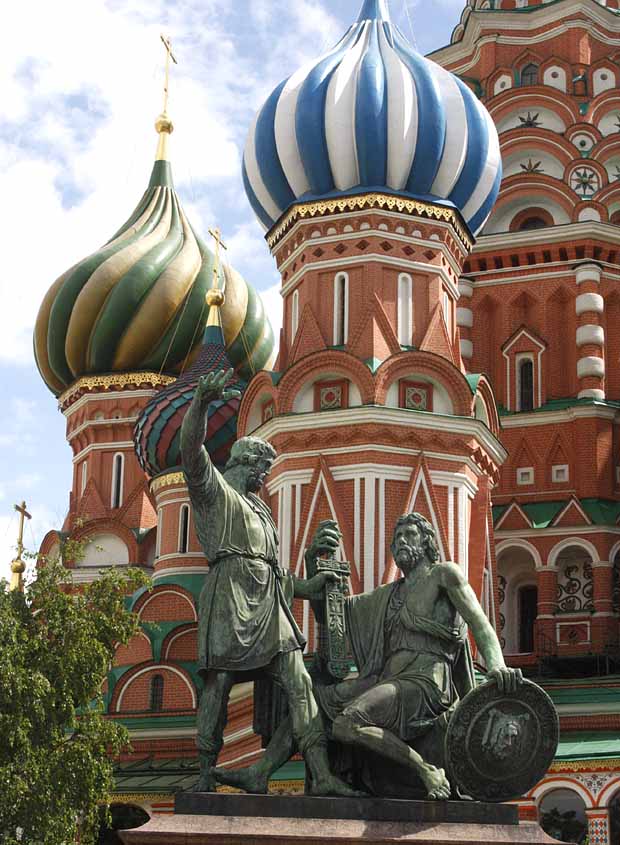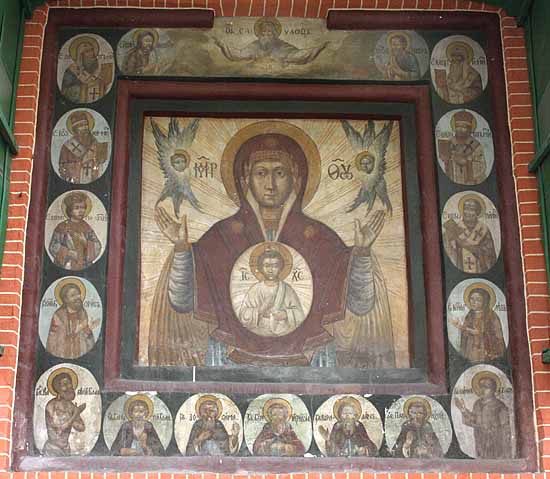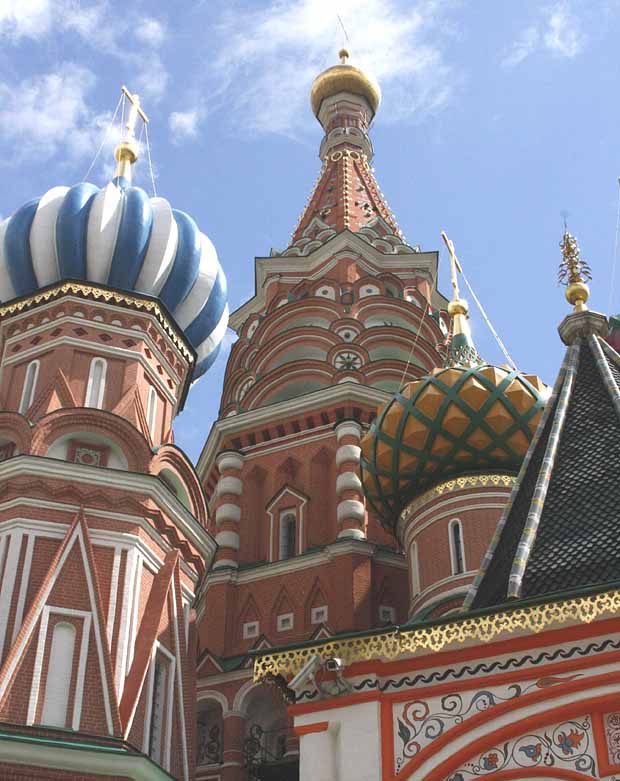|
Completed in 1561, the Cathedral of Saint Basil the Blessed (Cathedral of the Intercession of the Virgin) on Red Square was built by Ivan IV (Ivan the Terrible) to commemorate the defeat of the Tartar Mongols and the capture of the City of Kazan in 1552. The bronze statue in front of the cathedral depicts Dmitry Pozharsky and Kuzma Minin, two leaders of the Russian Army during the Time of Troubles in the late sixteenth and early seventeenth centuries. Dmitry Pozharsky and Kuzma Minin are credited with having organized and led the army of volunteers that expelled Polish invaders from Moscow in 1612. Following that event which marks the end of the Time of Troubles, they were instrumental in electing Mikhail Fyodorovich to be the first Romanov Czar in 1613. Two centuries later, during the reign of Alexander I, a competition was held to find a sculptor to create a monument celebrating this important historic event. Ivan Martos, a celebrated artist known for his neoclassical approach to sculpture, won the contest and started work on the project in 1808. Before he was finished, Napoleon invaded Russia and occupied Moscow in 1812. The statue was finally unveiled in 1818 and installed in the center of Red Square. After the 1917 Revolution Pozharsky and Minin's statue caused something of a dilemma for the Communist leadership. In the end, however, their value as patriotic figures outweighed their involvement in establishing the Romanov dynasty. In 1936, Stalin moved the statue to it's present location in front of St. Basil's Cathedral in order to get it out of the way of his military parades. Note that the neoclassicist sculptor dressed and armed the two men as Romans.
|
|
Ivan IV Vasilyevich, also known as Ivan the Terrible, was born in 1530 in Moscow, the son of Grand Prince Vasili III. On the death of his father in 1533, Ivan assumed the throne as Grand Prince of Moscow, at the age of three. Real political authority remained in the hands of a succession of regents until he took power to himself in 1544 at the age of fourteen. Early in 1547, not yet seventeen, he declared that he was the Czar of All Russia. This was the title used by all of his successors up until 1721 when Peter the Great established himself as Emperor of the Russian Empire. During the early part of his reign, Ivan created a standing army, a council of nobles, an assembly of the people, and revised the legal code. He also strengthened the Orthodox Church and introduced laws that limited the mobility of peasants. In 1552 he defeated the Khan of Kazan. He suffered a serious illness in 1553. During his illness he asked the boyars to swear allegiance to his eldest son. Many refused, thinking that Ivan was about to die. He recovered and went on to defeat the Khan of Astrakhan in 1556. Ivan's wife died in 1560 and he suspected boyars of poisoning her. During this period he murdered a number of leading personalities thought to be plotting to overthrow him. In 1570 plague ravaged Russian communities killing hundreds daily and drought repeatedly destroyed crops. Moscow was burned by Khan Deviet of the Crimea and, in the subsequent two decades, Ivan was forced to war with Sweden, Lithuania, Poland and Livonia. During this time, Ivan became deranged and, on his order, his personal guards murdered large numbers of people. In the Massacre of Novgorod alone, several thousand people were killed. In 1581 Ivan accidently killed his son and heir. Czar Ivan died in 1584 and was succeeded by another son, Feodor I. Feodor was mentally retarded and did not last long on the throne. It is suspected by some that Boris poisoned Ivan IV as part of his effort to assume the throne. Whatever the cause of Ivan's death, Boris Godunov did ascend to the throne in 1598.
|
|



